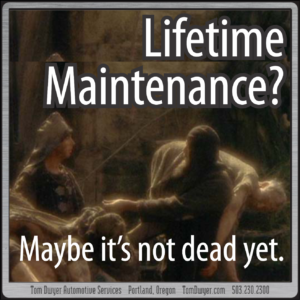‘Lifetime’ Maintenance?
Maybe it’s just not dead yet
As an auto shop we hear a lot of auto jargon, and one of the most dangerous phrases we hear recently is ‘lifetime’ maintenance or service. Some dealerships offer ‘lifetime maintenance’, and some manufacturers tout ‘lifetime fluids’, but it’s critically important to know precisely what they mean by lifetime. It’s almost certainly not what YOU think of as ‘lifetime’, and the difference can spell a much, much shorter lifetime for your vehicle…
In a classic Monty Python sketch, Eric Idle wanders through plague-ravaged England with a cart calling for people to ‘bring out their dead’. Someone has a corpse for the cart, but there’s a problem… it says it’s not dead yet! The problem is resolved after some haggling but the corpse was probably a little disappointed; HE was convinced his lifetime had quite a bit to go yet but HIS definition of ‘lifetime’ didn’t match up with the people in charge. He lost. “Lifetime Maintenance” is similar, and we’ve seen examples of at least two people getting stung by it.
“Don’t pay” isn’t the same as “Don’t do”
The first way we’ve seen someone hurt may have been a misunderstanding. We heard about it when an Extended Warranty company called us looking for some record… any record… of oil changes. A woman had been told (or had mistakenly heard) that her new vehicle “didn’t need maintenance for the first 100,000 miles”. While some manufacturers will tout ‘lifetime fluids’ (see below) and some will sell ‘free maintenance’ for the first 100K, oil is not a lifetime fluid and the free packages always include oil changes on a regular schedule. She had heard ‘don’t do any maintenance’ while the dealer meant ‘don’t pay for any maintenance’, but regardless, she didn’t do any maintenance at all for the first 100K miles. Without those critical oil changes her engine was destroyed, and the Warranty company didn’t cover the engine replacement her new vehicle now needed. If you take nothing else away from this article, please, please, please DO YOUR BASIC VEHICLE MAINTENANCE!
Your ’lifetime’ is not their ‘lifetime’
The second way is the fault of the Manufacturer, and it came up when a client was understandably upset that our advice differed from their vehicle manufacturer’s recommendation. Here’s part of our reply to them, but you can click here for the full response…
“…For example, there is no such thing as “lifetime transmission fluid”. The fluid in your Yaris breaks down over time like all transmission fluids do. It could very well make it to 100,000 miles without being replaced but the damage to your transmission will not be undone by a fluid replacement at that point. The Yaris has a design life of about 100,000 miles, meaning that if you follow the Toyota recommendations your Yaris is expected to reach the end of its service life in another 62,000 miles.”
To you, the life of a vehicle means “as long as you own it” but to a Dealer or Manufacturer the life of the car means its “expected design life”. This subtle difference matters. Your vehicle is a complex mechanical system and physics doesn’t change to suit preferences. Components get out of alignment, friction is real, parts wear out, fluids get dirty, oil gets thin. These are all real things that happen no matter what. If you don’t take care of maintenance early in the vehicle’s life, you won’t be able to play ‘catch up’ later.
Minimizing ‘overall cost of ownership’
This ambiguous wording is becoming common throughout the industry as cars get more expensive and manufacturers do everything they can to increase their price advantages over their competitors, especially on economy models. “Overall Cost of Ownership” is one of the prime competitive areas. To lower the lifetime cost they stretch prudent recommendations to the breaking point. As just one example, oil changes should be done about every 4000 miles (less often with synthetic oil), but if the manufacturer recommends changes every 6000 miles then they’ve cut the lifetime oil change expense by 33%. We’ve seen recommended manufacturer oil change intervals as high as 10,000 miles! This lowered cost of maintenance is an important sales point for them, but not in your interest if you intend to keep the vehicle for as long as possible.
Choose your path, let us know, then STICK WITH IT!
There are at least two approaches for planning vehicle maintenance. One is the “use it up” plan, where the owner does the absolute minimum maintenance knowing it will have a shorter useful life. The other is the “take care of it and drive it until the wheels fall off” plan, in which repairs are made and maintenance done proactively to extend the life of the vehicle as long as possible.
Our advice to you will differ depending on which approach you choose, but our default position is extending the useful life of the vehicle. There are valid reasons to follow either path, but you must choose early in the vehicle’s life! If you start out doing no maintenance then it may be impossible to undo the damage as the vehicle ages. Balance your budget, ownership goals, and vehicle needs, and then TALK WITH OUR SERVICE ADVISORS! No matter what plan you choose for your vehicles’ lifetime, our job is to help you achieve THAT goal… not ours!












